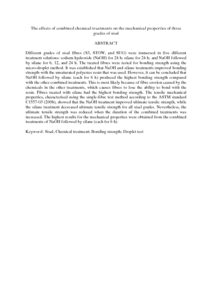Citation
Ibraheem, Sameer Adnan and Sreenivasan, Subramania Sarma and Abdan, Khalina and A. Sulaiman, Shamsuddin and Ali, Aidy and Abang Abdul Majid, Dayang Laila
(2016)
The effects of combined chemical treatments on the mechanical properties of three grades of sisal.
BioResources, 11 (4).
pp. 8968-8980.
ISSN 1930-2126
Abstract
Different grades of sisal fibres (S3, STOW, and SUG) were immersed in five different treatment solutions: sodium hydroxide (NaOH) for 24 h; silane for 24 h; and NaOH followed by silane for 6, 12, and 24 h. The treated fibres were tested for bonding strength using the micro-droplet method. It was established that NaOH and silane treatments improved bonding strength with the unsaturated polyester resin that was used. However, it can be concluded that NaOH followed by silane (each for 6 h) produced the highest bonding strength compared with the other combined treatments. This is most likely because of fibre erosion caused by the chemicals in the other treatments, which causes fibres to lose the ability to bond with the resin. Fibres treated with silane had the highest bonding strength. The tensile mechanical properties, characterised using the single-fibre test method according to the ASTM standard C1557-03 (2008), showed that the NaOH treatment improved ultimate tensile strength, while the silane treatment decreased ultimate tensile strength for all sisal grades. Nevertheless, the ultimate tensile strength was reduced when the duration of the combined treatments was increased. The highest results for the mechanical properties were obtained from the combined treatments of NaOH followed by silane (each for 6 h).
Download File
![[img]](http://psasir.upm.edu.my/52992/1.hassmallThumbnailVersion/The%20effects%20of%20combined%20chemical%20treatments%20on%20the%20mechanical%20properties%20of%20three%20grades%20of%20sisal.pdf)  Preview |
|
PDF (Abstract)
The effects of combined chemical treatments on the mechanical properties of three grades of sisal.pdf
Download (5kB)
| Preview
|
|
Additional Metadata
Actions (login required)
 |
View Item |



